- Clinical Technology
- Adult Immunization
- Hepatology
- Pediatric Immunization
- Screening
- Psychiatry
- Allergy
- Women's Health
- Cardiology
- Pediatrics
- Dermatology
- Endocrinology
- Pain Management
- Gastroenterology
- Infectious Disease
- Obesity Medicine
- Rheumatology
- Nephrology
- Neurology
- Pulmonology
Subacute Onset of Paralysis in a Person With AIDS
The pathogen Toxoplasma gondii is an intracellular protozoan that most commonly presents in persons with AIDS as reactivation of latent infection.
The pathogen Toxoplasma gondii is an intracellular protozoan that most commonly presents in persons with AIDS as reactivation of latent infection. Affected persons usually have headache, fever, altered mental status, seizure, and/or neurological deficit secondary to 1 or more brain lesions.1,2 We present a case of an HIV-infected person with toxoplasmosis that presented as a neurological deficit resulting from a spinal cord lesion.
CASE SUMMARY
A 46-year-old African American woman whose AIDS diagnosis was reported in 1985 presented with gradual onset of bilateral lower extremity weakness over the previous 6 months. She was hospitalized for right leg pain. She reported falling 3 days before presenting.
The patient denied headache, visual changes, bowel or bladder incontinence, rash, and fever. She had a history of poor adherence to her treatment regimen and was not currently receiving any antiretroviral or prophylactic medications. Her most recent CD4+ cell count was 60/µL and plasma HIV RNA level was greater than 750,000 copies/mL. On physical examination, the patient had a supple neck; her leg strength was 2/5 on the right side and 3+/5 on the left side.
A gadolinium-enhanced MRI scan of the brain showed numerous lesions throughout the supratentorial and infratentorial regions (Figure 1). A gadolinium-enhanced MRI scan of the spine showed multiple lesions in the thoracic spine associated with extensive edema (Figure 2). Results of a lumbar puncture demonstrated an opening pressure of 160 mm H2O, and the cerebrospinal fluid (CSF) sample showed a white blood cell count of 21/µL (normal, less than 5), with 97% lymphocytes and 3% monocytes; red blood cell count of 11/µL; total protein level of 259 mg/dL (normal, 15 to 45); and glucose level of 33 mg/dL (normal, 40 to 80). Findings from cytological examination of the CSF were negative, and results of a test for Cryptococcus antigen were negative. Gram stain showed no cells or organisms, and routine aerobic culture showed no growth.
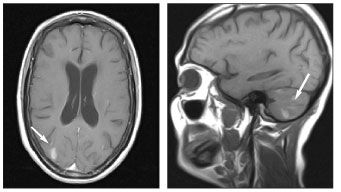
Figure 1. Sagittal and coronal gadolinium-enhanced MRI scan of the brain at presentation. The arrows point at the brain lesions.
Diagnosis and Treatment
During her initial evaluation by the inpatient HIV consult service, the patient recalled being treated for “toxoplasmosis of the brain” in 1998. Review of her records confirmed that the patient had positive serum anti-Toxoplasma IgG. Because of her lack of medication adherence, she had not taken medications for toxoplasmosis suppression for at least 6 months before her current admission. A test for CSF anti-Toxoplasma IgG yielded positive results. The patient was given a presumptive diagnosis of relapsing toxoplasmosis involving the brain and spinal cord based on the prior history of toxoplasmosis, clinical presentation, and the results of the imaging and laboratory tests. Attempts to obtain records to ascertain whether the patient had spinal cord involvement during her initial infection in 1998 were unsuccessful. Because of the risks of the procedure, a spinal cord biopsy was not done to confirm the diagnosis.

Figure 2. Gadolinium-enhanced MRI scan of the thoracic spine at presentation. The arrows point at the spinal cord lesions.
Treatment with pyrimethamine, sulfadiazine, and folinic acid was started, along with a 2-week course of tapered dexamethasone for spinal cord edema. Within 1 week, the patient improved clinically, with increased motor strength. Gadolinium-enhanced MRI scans of the spine, done after 1 month (Figure 3) and 2 months (Figure 4) of anti-Toxoplasma therapy, and of the brain, after 7 months (Figure 5) of therapy, showed progressive resolution of the spinal cord and brain lesions.
Antiretroviral therapy was prescribed 2 months after hospitalization; however, the patient did not consistently adhere to her regimen, and her plasma viral load remained elevated. She also stopped taking her anti-Toxoplasma medications. Subsequently, progressive neurological symptoms developed, and the patient died 1 year after the diagnosis of spinal cord toxoplasmosis was made.
DISCUSSION
Spinal cord toxoplasmosis is rare, and patients usually present with fever, headache, back pain, motor or sensory deficits, ataxia, and/or loss of bowel or bladder control. It may or may not be associated with brain involvement.1,2 The differential diagnosis of spinal cord lesions in a person with AIDS includes lymphoma, toxoplasmosis, tuberculosis, cytomegalovirus infection, herpes simplex virus infection, herpes zoster virus infection, cryptococcosis, aspergillosis, and neurosyphilis.1-3
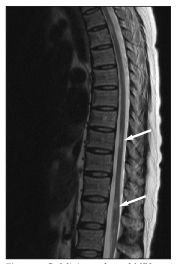
Figure 3. Gadolinium-enhanced MRI scan of the thoracic spine after 1 month of therapy. The arrows point at the spinal cord lesions.
Humans are commonly infected through ingestion of raw or undercooked meat containing tissue cysts or by accidental ingestion of oocysts excreted in cat feces. The results of the National Health and Nutrition Examination Survey (NHANES) for 1999 to 2004 showed that the seroprevalence of anti-Toxoplasma IgG in the United States was 10.8%, which was lower than the prevalence reported in the NHANES survey for 1988 to 1994.4,5 The seroprevalence of anti-Toxoplasma IgG was higher in the Northeast than in other regions of the United States.5 It was higher among non-Hispanic blacks (11.5%) than among non-Hispanic whites (8.8%). Higher risk of latent infection was associated with older age (50 years and older), low CD4 counts, low socioeconomic conditions, and foreign birth.5,6 Seroprevalence of anti-Toxoplasma IgG in France was found to range from 50% to 75%.3,6
All HIV-infected patients should be screened for serum anti-Toxoplasma IgG at the time of HIV infection diagnosis. Its presence indicates past exposure. Seronegative patients should be counseled to avoid eating undercooked meat and to wear gloves when cleaning cat litter boxes.3
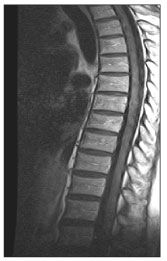
Figure 4. Gadolinium-enhanced MRI scan of the thoracic spine after 2 months of therapy.
In persons with AIDS, toxoplasmosis usually reactivates when the CD4+ cell count is less than 100/µL.1 In the pre-HAART era, the 12-month incidence of Toxoplasma encephalitis in seropositive patients with CD4+ cell counts of less than 100/µL was 33% in those not receiving primary prophylaxis.3 Consequently, primary prophylaxis should be started in seropositive patients when their CD4+ cell count falls below 100/µL (Table). The sulfamethoxazole treatment used for Pneumocystis jiroveci pneumonia (PCP) prophylaxis can prevent toxoplasmosis.7 The overall incidence of the disease has decreased since the introduction of effective antiretroviral therapy and PCP prophylaxis.8-11
In the majority of patients with HIV infection who have Toxoplasma encephalitis and spinal cord involvement, serological test results are positive for Toxoplasma.2 Anti-Toxoplasma IgG appears early, peaks within 6 months, and is lifelong. Absence of serum anti-Toxoplasma IgG makes the diagnosis unlikely, although toxoplasmosis occasionally occurs in this setting. Quantitative titers are not helpful diagnostically. While CSF positive for anti-Toxoplasma antibody is associated with reasonable specificity, sensitivity is low.12 The polymerase chain reaction assay for Toxoplasma DNA in CSF has low sensitivity, and serum anti-Toxoplasma IgM is usually absent at the time of reactivation.3,12
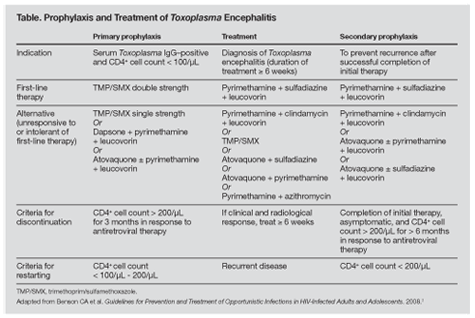
At the time of reactivation, MRI and CT scans of the brain typically show multiple ring-enhancing lesions. If the spinal cord is involved, edema and/or intramedullary enhancing lesions are seen. With brain or spinal cord involvement, the CSF often has a high protein level and minimal pleocytosis.2
Treatment of toxoplasmosis is usually empiric. A presumptive diagnosis is based on a CD4+ cell count of less than 100/µL, a positive serological test for Toxoplasma, an appropriate clinical picture, typical radiological appearance on CT or MRI scan, and a lack of an alternative diagnosis. Brain biopsy can confirm the diagnosis; the organisms are seen using hematoxylin and eosin stain or immunoperoxidase stain. However, brain biopsy is usually used for the purpose of identifying alternative diagnoses in patients who do not respond to therapy within 10 to 14 days. Positron emission tomography or single photon emission CT scanning can help distinguish toxoplasmosis from primary CNS lymphoma.1
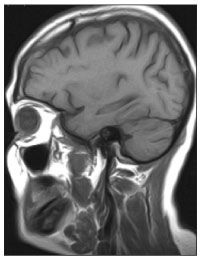
Figure 5. Gadolinium-enhanced MRI scan of the brain after 7 months of therapy.
Treatment of toxoplasmosis consists of the combination of sulfadiazine and pyrimethamine (Table). Clindamycin can be substituted for sulfadiazine if intolerance develops. Leucovorin (folinic acid) is added to prevent pyrimethamine-associated hematopoietic toxicity. If edema or midline shift is present at diagnosis, corticosteroids may be given as brief, adjuvant therapy. Anticonvulsants are not routinely used. Initial therapy is administered for 6 weeks, followed by long-term suppressive treatment at lower doses.
No potential conflict of interest relevant to this article was reported by the authors.
References:
References1. Skiest DJ. Focal neurological disease in patients with acquired immunodeficiency syndrome. Clin Infect Dis. 2002;34:103-115.
2. Vyas R, Ebright JR. Toxoplasmosis of the spinal cord in a patient with AIDS: case report and review. Clin Infect Dis. 1996;23:1061-1065.
3. Benson CA, Kaplan JE, Masur H, et al. Guidelines for Prevention and Treatment of Opportunistic Infections in HIV-Infected Adults and Adolescents. Recommendations of the National Institutes of Health (NIH), Center of Disease Control and Prevention (CDC), and the HIV Medicine Association of the Infectious Diseases Society of America (HIVMA/IDSA). June 18, 2008:1-139.
4. Jones JL, Kruszon-Moran D, Sanders-Lewis K, Wilson M. Toxoplasma gondii infection in the United States, 1999-2004, decline from the prior decade. Am J Trop Med Hyg. 2007;77:405-410.
5. Jones JL, Kruszon-Moran D, Wilson M, et al. Toxoplasma gondii infection in the United States: seroprevalence and risk factors. Am J Epidemiol. 2001;154:357-365.
6. Falusi O, French AL, Seaberg EC, et al. Prevalence and predictors of Toxoplasma seropositivity in women with and at risk for human immunodeficiency virus infection. Clin Infect Dis. 2002;35:1414-1417.
7. Carr A, Tindall B, Brew BJ, et al. Low-dose trimethoprim-sulfamethoxazole prophylaxis for toxoplasmic encephalitis in patients with AIDS. Ann Intern Med. 1992;117:106-111.
8. San-Andres FJ, Rubio R, Castilla J, et al. Incidence of acquired immunodeficiency syndrome-associated opportunistic diseases and the effect of treatment on a cohort of 1115 patients infected with human immunodeficiency virus, 1989-1997. Clin Infect Dis. 2003;36:1177-1185.
9. Abgrall S, Rabaud C, Costagliola D; Clinical Epidemiology Group of the French Hospital Database on HIV. Incidence and risk factors for toxoplasmic encephalitis in human immunodeficiency virus-infected patients before and during the highly active antiretroviral therapy era. Clin Infect Dis. 2001;33:1747-1755.
10. Brodt HR, Kamps BS, Gute P, et al. Changing incidence of AIDS-defining illnesses in the era of antiretroviral combination therapy. AIDS. 1997;11:1731-1738.
11. Sacktor N, Lyles RH, Skolasky R, et al; Multicenter AIDS Cohort Study. HIV-associated neurologic disease incidence changes: Multicenter AIDS Cohort Study, 1990-1998. Neurology. 2001;56:257-260.
12. Brown K, Skiest D. Toxoplasmosis of the central nervous system: pathophysiology, diagnosis and treatment. In: Goodkin K, Shapsak P, Verma A, eds. The Spectrum of Neuro-AIDS Disorders. Herndon, VA: ASM Press; 2008:313-329.
